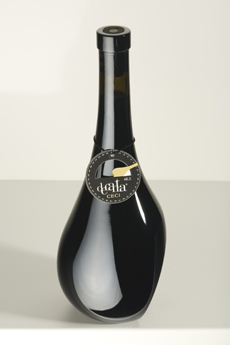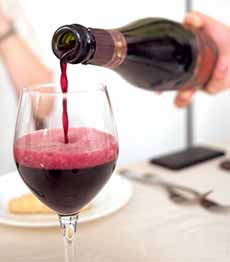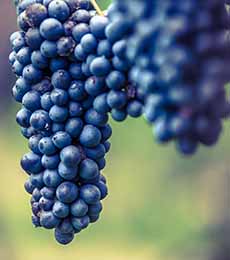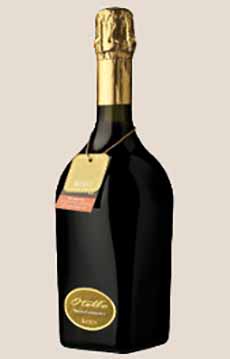The New Wine Bottle-Decanter From A Lambrusco Producer
|
|
Congratulazioni to the designers at Cantine Ceci in Torrile, Italy (outside Parma). Their patented wine bottle innovation, “Decanta 68.2” has won an award at the International Packaging Competition at Vinitaly 2010. It will be presented to consumers during the large Italian wine fair, which runs from April 8th to the 12th in Verona. This “evolution of the species” is the first combination wine bottle-decanter: useful to decant wine with sophistication in design. Decanta 68.2 can serve as a gift, a table decanter and a tabletop objet d’art. When set on its side, the degree of tilt enables perfect oxygenation. The label side is placed down on the table, so the line of the design is not interrupted. The cork is made from silicone so it can be easily re-corked (and reused with other wine!). In addition to Decanta 68.2, Cantine Ceci is about to introduce Rock Otello Dry, the first sparkling wine in a square bottle (photo #4). Now the practical question: Can smaller retailers easily fit these larger-footprint bottles on the shelves? The gauntlet has been thrown.* It’s no longer good enough to create a wine with a nifty name and label design. The challenge now is to out-bottle-design your competitors. Winemakers of the world, take heed! > The history of Lambrusco is below. One of the most ancient wines, Lambrusco is a sparkling red wine from the Emilia-Romagna region northeast of the Tuscany region of Italy: Mantua, Modena, Parma and Reggio nell’Emilia. Today, the red wine is also made in the neighboring Lombardy region. It is the name of both the grape and the wine made from it. Different appellations make different styles, with their own unique character and grape varieties or blends. Styles range from dry to sweet from fruity to savory, depending on what grapes have been used in the blend, where they are grown, and how the wine is made. Bottles labeled Lambrusco Reggiano DOC are produced from grapes grown throughout the region. The region, whose capital is Bologna, has a rich gastronomic history: balsamic vinegar of Modena, Parmigiano Reggiano, Prosciutto di Parma, and mortadella all hail from Emilia-Romagna. Lambrusco is a versatile, food-friendly wine which pairs well with light and rich dishes, spicy and aromatic dishes (try a slightly off-dry Lambrusco with coconut curry, for example.) Start your discovery with four wines that are good “starters” to exploring the category: Cleto Chiarli, Medici Ermete, Terrevive, and Venturini Baldini. Archaeological evidence indicates that the Etruscans cultivated the vine as far back as 900 B.C.E. (predating Ancient Rome, 753–509 B.C.E. to 476 C.D.). In Roman times, the Lambrusco grape was highly valued for its productivity and high yields. Cato the Elder mentioned that two-thirds of an acre of vines could make enough wine to fill 300 amphorae [source]. The Renaissance, a more dedicated approach to viticulture helped improve the wine, which became more visible in written documents. In 1597 Andrea Bacci, the physician to Pope Sixtus V, wrote of the vineyards cultivated between Modena and Parma as being “famous for some white and red wines, pleasingly sparkling and with attractive perfumes…” [source]. In the 18th and 19th centuries, technological breakthroughs for producing sparkling wines enabled the production and bottling to have a longer shelf life without spoiling. The early 20th century saw the birth of social cooperatives, with a mission to protect the growers of Lambrusco, create special sales channels, and safeguard their earnings. In 1961, Lambrusco producers created the first consortium for Lambrusco wines. Today, the many consortia that were created subsequently are united under the Consorzio Tutela Lambrusco DOC. In the 1980s and 1990s, Lambrusco became one of Italy’s most popular wine exports. It should be easy to find in your nearest wine or liquor store. ______________ *If you don’t know what a gauntlet is: It’s a knight’s glove, made of mail or plate, worn to protect the hand in combat (hopefully, it matched one’s armor!). When one knight wanted to challenge another, he threw down his gauntlet, which landed at the feet of the prospective combatant. If the second knight accepted the challenge (and he was generally honor-bound to do so), he picked up the gauntlet. Now for the big question for Medieval historians: Did the challenger get his gauntlet back when his challenge was accepted, or did the challenged knight get to keep it? †Amphorae (photo #5) stored and transported a variety of foods in the ancient world: fish, grains grapes, olive oil, olives, wine, and more. They varied greatly in height. Approximately 66 distinct types of amphora have been identified. The Etruscans imported, manufactured, and exported amphorae for wines. Amphorae dated to approximately 4800 B.C.E. have been found in a Neolithic site in China. Amphorae first appeared on the Phoenician coast at approximately 3500 B.C.E. The Roman wine amphora held a standard measure of about 39 liters (41 quarts), which led to the amphora quadrantal (about 25.9 liters) as a unit of measure The volume of a Roman amphora was one cubic foot, about 26.026 liters. The term also stands for an ancient Roman unit of measurement for liquids [source]. |
|
|
CHECK OUT WHAT’S HAPPENING ON OUR HOME PAGE, THENIBBLE.COM. |
||







